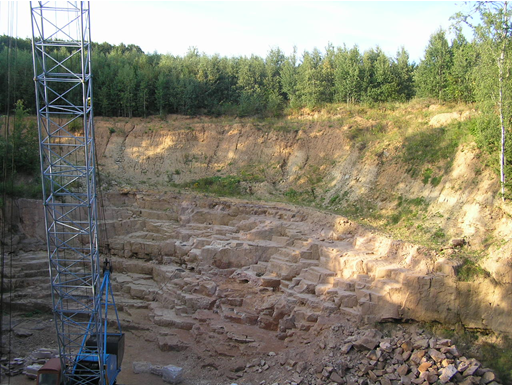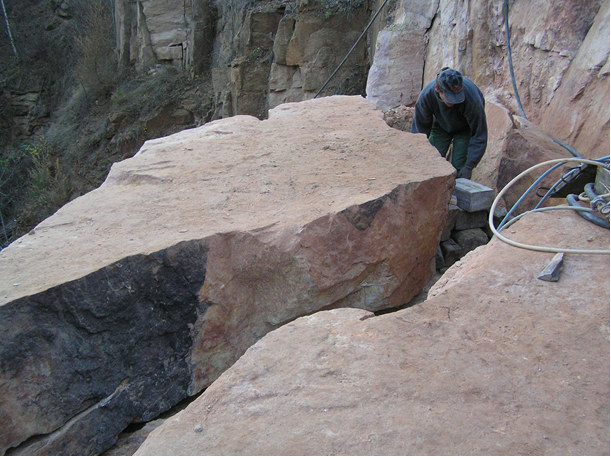UNIQUE SANDSTONE FROM BĚLOHRAD – ITS USE IN SCULPTURE ART AND MINING TRADITIONS

“In every stone a scupture is hidden.”
Michelangelo Buonarroti (1475-1564)
Picture 1 – Sandstone quarry in Lázně Bělohrad
Sandstone from the quarry in Lázně Bělohrad is unique in whole Europ efor its unique crystallization of iron dyed through yellow sandstone into pink-red-purple marble which cannot be found elsewhere in Europe. While meeting all the primary standards for natural stone, it is its colour that makes this type of sandstone so attractive.
Customers are attracted by the reddish pattern of the sandstone and appreciate its pleasant look within combination house and garden which determines its use. Sand plinths, parapets, window sills, door sills or staircases which complement garden architecture such as garden parapets, fences, fireplace, terraces, benches, flower pots, ponds, and fountains. Use of stone for fireplaces and tiling in interior creates comprehensive impression. Warm colours of natural stone and carefully chosen plants create wonderful places with their beauty and uniqueness.
Mining and processing of sandstone from Lázně Bělohrad out of which town of Lázně Bělohrad was built took place from 1943 and it was revived in 1995. The oldest preserved demonstration of its use is the plague column on the square which dates back to 1657.
Two special sculptures were made of the Bělohrad sandstone – Sculpture of St Procopius and St Agnes of Bohemia.
The first sculpture was created to commemorate St Procopius, the patron saint of the Czech Lands and of miners. St Procopius lived between the 10th and 11th century. He was born around 970 in Chotouň in a yeoman stronghold. He received his education at Vyšehrad school where he was taught Slavic language. He became a priest and later a monk in the Benedictine monastery of Břevnov. Following the slaughter of Slavník dynasty he lived as a hermit in a cave in the Daleje forest at Jinonice. There St Procopius probably wrote down a copy of the holy gospel which then ended in France where French kings took oaths on it (i.e. “texte du sacre”). Then Procopius left for forested land near the Sázava river. In that time people saw Procopius force the devil to plough. The devil was yoked and forced by the saint cross held in Procopius’ right hand to plough a furrow between the villages of Chotouň and Sázava. Some of the furrow is still visible today. The hermitage gradually became a settlement of monks which then laid foundations for the Sázava monastery. The monastery was supported by Duke Oldřich and its successor Břetislav. Procopius became its first abbot. St Procopius with his attributes – devil kept on a metal chain – a symbol of spiritual struggle and overcoming the powers of darkness.

For World of Stone provided by author: František Žoček
